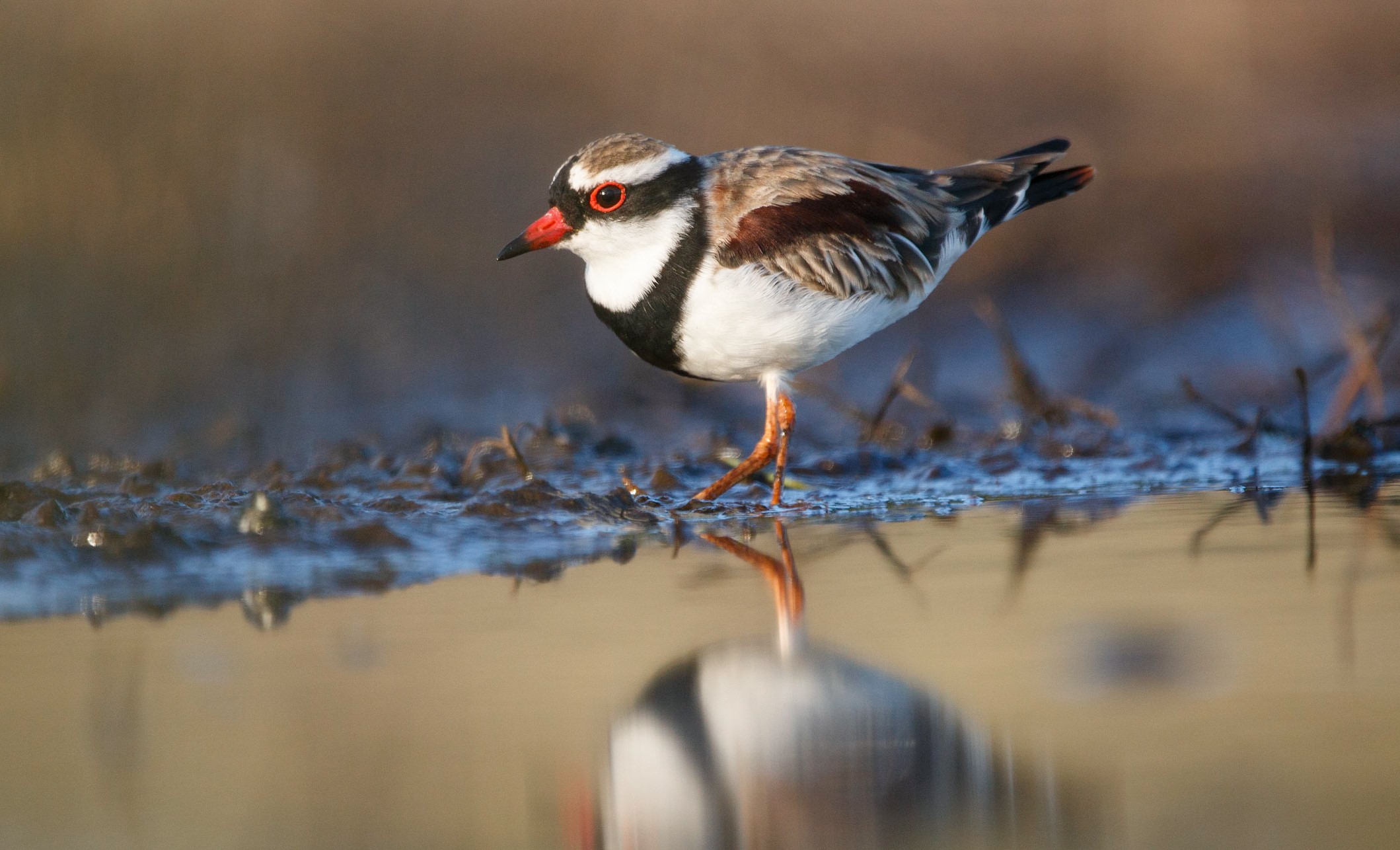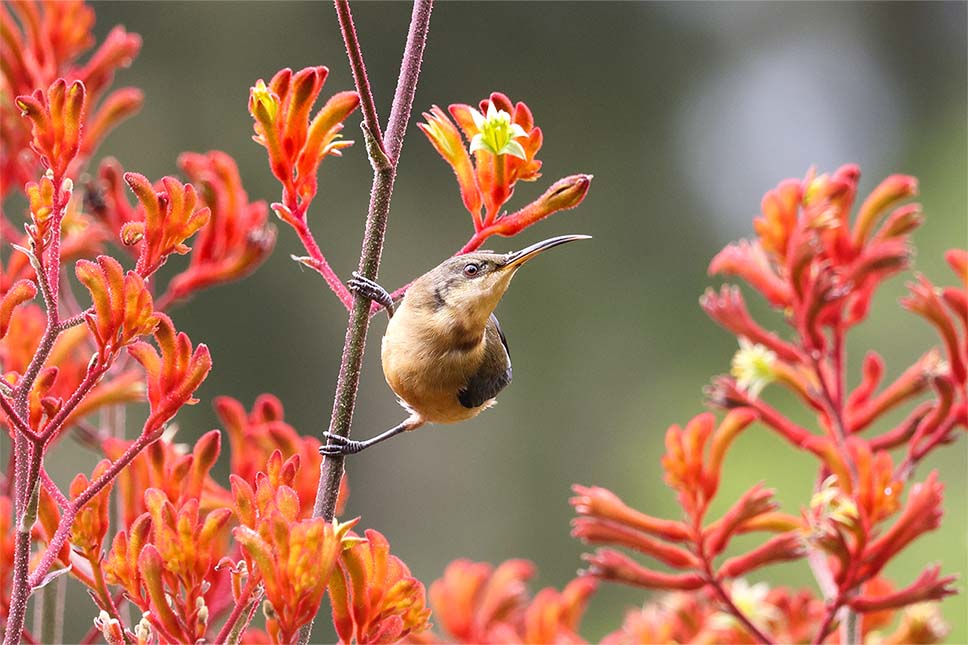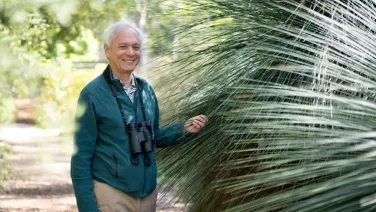
Am I a Bad Birder?
The state of ‘flow’ is hard to come by, but right now, I’m in it.
The sun is rising over the wetlands, and I am nestled in some water reeds. It’s just me, a buff-banded rail, some Australasian swamphens, and the odd long-necked turtle.
Ooh, and there’s some little black-fronted dotterels running along the mudflat. And some red-rumped parrots coming in for a drink. I can also hear eastern rosellas, galahs, and superb parrots in the distance. And maybe that’s a reed warbler flitting about on the other side.
For me, this is heaven. But then my flow-state is broken by an intrusive thought: with all this birdlife around – shouldn’t I be recording them into eBird, the global birding app? I scrabble around for my phone and start searching for each species in the dropdown menu to make a list.
While I’m looking down at my phone, the normally shy buff-banded rail, which is now only a few metres in front of me, starts dipping its beak into the water and feeding. I look up from my screen, and to my dismay, the bird is gone.
I’ve missed the moment. While I feel bad about that, I simultaneously feel guilty for not being more conscientious about recording my observations.
It seems my stress about being a ‘good’ birder is getting in the way of my hobby. Sometimes there are so many apps and projects to contribute to, that I feel a bit overwhelmed. Do I add it to eBird, iNaturalist and Nature Mapr? What about other worthy citizen science projects that I hear about? They’re all collecting data which is essential for practical environmental conservation.
Now I’m neither in the moment nor helping science.
Some birders have logged thousands of eBird checklists across the globe; I’ve done nothing close to that. What counts as contributing enough? Is it selfish or anti-science to prioritise a walk in nature, noticing birds for my own joy and mental health, over submitting bird lists?
Am I, in fact, a Bad Birder?

To find out if I’m overthinking this, I reach out to someone much wiser than me, Emeritus Professor Libby Robin from ANU Fenner School of Environment and Society. She is the author of a book called What Birdo is That?, where as a self-confessed birdo, she turns the figurative binoculars onto birdos themselves. She can tell me if I’m doing this birding thing right.
Professor Robin says birdos, birders, birdwatchers (whatever term you want to use) fall into a bunch of different types: some like to create lists; some are looking for rarities; some appreciate common bird species; some have lots of biological knowledge; some are photographers; some are expert at identifying species; some aren’t. Professor Robin suggests that there is no one type better than the other.
“Do you notice birds?” Professor Robin asks me. I nod, and my kingfisher earrings jangle. We’re seated facing a window over the Australian National Botanic Gardens and a pied currawong has just swooped past.
“When you see them, does that make you happy?” Of course. “Then you’re a birder.”
She tells me that birding has changed a lot since the digital age, particularly with the advancement of apps like eBird. It’s becoming more popular, for starters. It’s also become more inclusive and accessible.
She says there are many arguments to be had about the pros and cons of eBird, but the thing she’s most focused on is that we’re out there birding at all.
“In life, everything is online,” she says. “The most important thing is for us is to get off the screen some of the time. Get some air. You just need a break from screens. And birding is that break.”
“If you're constantly looking at your device, or writing things down, you might miss the big story,” she adds.
When it comes to birding, the big story may be quite small. Like the rustle of leaves that alerts you to a critically endangered regent honeyeater in the tree above you. Or perhaps the nest hollow, previously overrun by introduced common mynas, has a new native tenant.
It’s stuff that only comes through being in nature, noticing, learning, and connecting the dots. It’s important. “In fact,” Professor Robin says, “caring about birds might just change the world.”
When you care about something, you act. You might plant a native bird and pollinator-friendly garden. Or you could write to your MP urging them to prioritise nature-first policies. You might become a citizen scientist, or simply share the joy of watching birds with others.
I leave our conversation feeling lighter because I know I care about birds, even if those feelings don’t translate immediately into direct action.

It turns out that even scientists share my struggle.
Ecologist Dr Belinda Wilson tells me she can relate to my feelings of guilt. She’s a researcher at the ANU Fenner School of Environment and Society, a quoll expert, a science communicator, and a birder.
She says she often feels an obligation to be “doing more”.
“Because we can’t protect the things we don’t know exist, I find it very difficult just to go out for a bushwalk without collecting some sort of data.”
But it really comes down to what you value, and then what you can sustain, she says.
“Do you just want to enjoy the experience for what it was? Walking around, hearing the wind in the trees, hearing the calls, smelling, touching... or do you want to digitise that experience and make sure that it gets to the right channel so that it can be actioned?”
She summarises it perfectly: “One side is very flowy, and great for the soul. And the other one can be a bit draining.”
That’s what I’ve been trying to articulate: it’s this push and pull between my head and my heart that I want to learn how to balance.
I imagine, for a scientist, this kind of obligation is even stronger than mine. I’m someone who’s around science a lot, but Dr Wilson is in it. She is also a passionate science communicator, and she knows how valuable it can be to share science to an even wider audience.
“I’m realising that there is a constant pressure on those working in the environmental sector to always do more. While there is a literal life-and-death element to conserving biodiversity, we also know we have to take care of ourselves first – because if we don’t, we can’t contribute to the other lives and world outside of us and make a difference.
“There's absolutely a balance to be struck. I don't know if I'm there yet.”
But citizen science apps have a lot to offer back to the user too. Having a list of all the birds she’s ever spotted, with her photos included, is very satisfying and joyous for Dr Wilson. Citizen science projects can also connect you with community, help you learn more about nature, and make you feel good about contributing – even in a small way.
“I took a picture of an orchid a couple of years back, and apparently it had been a brand-new location for that species,” Dr Wilson says. “People started messaging me on Canberra Nature Map – it turns out it was a significant recording! It just makes me want to take more recordings – can you imagine what else is flying under the radar out there?”
You can always upload your photos and data after the fact too, Dr Wilson adds.
For me, that feels more achievable. I can jot my observations in a notebook while in the field and upload records when I’m back home.
She also says not to worry about which app you choose: use the one that speaks to you most. The Atlas of Living Australia congregates data from most citizen science apps in Australia, anyway.
“Do things that bring you energy and joy,” Dr Wilson concludes. “Because otherwise, what are we even doing?”

So I’m not, after all, a Bad Birder. But maybe I need to become a more Balanced Birder.
In my notebook, I write down the words ‘My birding goals’ and underline it. I write:
- participate in Birdlife Australia’s four seasonal bird surveys,
- add interesting local cockatoo observations to the Big City Birds app, and
- upload photos of rare birds or tricky-to-ID species to iNaturalist.
With this plan I can fully invest in the projects I want to focus on, while also carving out time to just be. I’d much rather be motivated by what I can do, instead of what I’m not doing.
Having settled on some concrete contributions and parameters, I feel like I can let of go of some of that guilt; let it fly away like a flock of galahs on the roadside. Because when it comes down to it, my main goal is that I remain a birder, and someone who cares. That’s what really matters.
It’s the end of the day. I’m walking home with a heavy backpack and sore feet, when I suddenly hear a distinct drawn-out crackly sound, like a pterodactyl – or as if the gum trees above me are threatening to drop a limb.
But there’s no danger here, it’s just the call of a beautiful dark grey gang-gang as it flies by. I smile and squint up at the spot she came from, wondering if her partner might be here too. He is. The flashy red crest is easy to see flying towards me.
The pair land on a knot of the tree next to a hollow, and squawk around comically. They peek in and around their tree hollow home, and then start to preen each other.
I stand at the base of the tree and hang out with the gang-gangs for a while, watching their antics as the setting sun streams through the tree branches. My fingers hover over the app library on my phone, but then I change my mind and slip my phone back in my pocket.
Today, this one’s just for me.
Cover image by Elsie Percival



